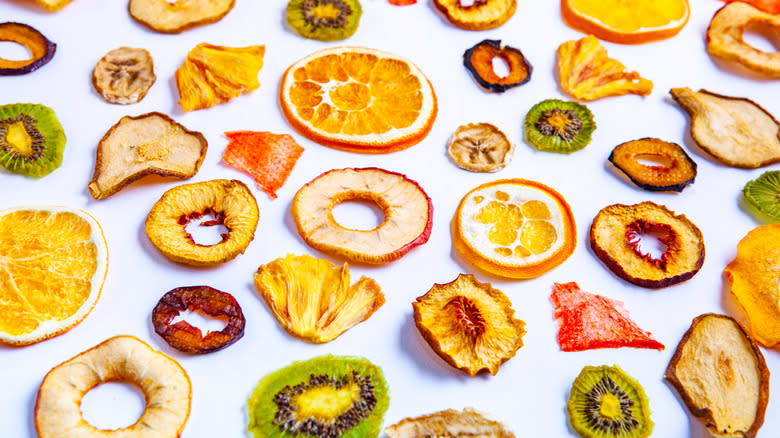Why It Pays To Soak Fruit Before Dehydrating In The Oven

Dehydrated fruit, with its intense flavor and natural sweetness, is a delightful snack that can be enjoyed year-round. If you're looking to take your dehydrated fruit to the next level, here's a game-changing tip: Soak it in water before placing it in the oven. Let's explore why this seemingly simple step can make your dehydrated fruit better, along with some tips for the best results.
Soaking fruit before dehydrating may seem counterintuitive, but it can significantly enhance the quality of your final product. One of the primary benefits of soaking fruit is that it helps prevent browning or burning during the dehydration process. When fruit slices are soaked in water, they absorb moisture, which acts as a protective barrier against excessive heat. This means your fruit will dehydrate evenly without any unsightly burnt spots. Consider also adding a splash of lemon juice to the soaking water; this not only helps prevent browning but also imparts a subtle citrus zing to your fruit.
This slight rehydration the fruits undergo helps maintain their natural juiciness and texture, resulting in plump, tender pieces. The process also can intensify the fruit's natural flavor, making your baked treats burst with its sweet essence.
Read more: 23 Whole Foods Baked Goods, Ranked
Follow These Tips For The Best Results

Not all fruits require soaking before dehydration; the method works best for somewhat fibrous/grainy fruits like apples, pears, and peaches, which tend to brown and dry out too quickly. While fruits with a somewhat porous skin (kiwi or peaches, for example) can be dropped into a bowl unpeeled those with thicker, waxy skins like apples should be peeled before soaking.
Soak your fruit for about 10 to 15 minutes. You want them to rehydrate slightly without becoming waterlogged, so check their texture periodically, and pull them out before they develop any mushiness. After soaking, drain your fruit, and pat them dry with a clean towel. Excess moisture can extend the drying time and even lead to mold growth. After soaking, slice your fruit pieces evenly — about a quarter to an eighth inch thick — to ensure uniform drying. Arrange your fruit slices in a single layer on your baking sheets, and make sure they aren't touching each other for optimal airflow.
Keep a close eye on your fruit as it dries out in the oven. The time required can vary depending on the fruit and your drying conditions. It's done when it feels leathery but not brittle. Allow your dehydrated fruit to cool completely before storing it in an airtight container. This helps prevent condensation and prolongs shelf life. So, the next time you prepare a batch of dehydrated fruit, don't forget the soaking step -- it's the secret to making your snacks truly exceptional.
Read the original article on Tasting Table.


